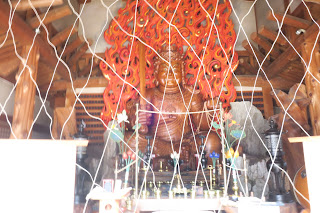The official name is Kamei Yamakata Koin Daiganji. The founding of the temple
is unknown, but it is an ancient temple of the Shingon sect that is said to
have revived the monk Ryokai during the Kenjin period (1201-1203).
Until the Meiji decree to separate the gods from the Buddha, he was in charge
of repairing and building temples as a general contractor of the Hakushima
Shrine, and was the center of the Itsukushima temple formed from the
Senjokaku, the five-storied pagoda, and the Tahoto.
In addition, the Shoin at the back of the main hall is known as the place
where Katsu Kaishu and the feudal lords representing the Choshu clan held a
peace conference during the Second Choshu War.
|
Nio guardians.
Nio are two wrathful and muscular guardians of the Buddha standing today
at the entrance of many Buddhist temples in East Asian Buddhism in the
form of frightening wrestler-like statues.
-
They are usually portrayed as a pair of figures that stand guarding
temple entrance gates usually called Shanmen in China, Niomon in Japan
and Geumgangmun in Korea.
-
The right statue (top) is traditionally called Guhyapada and has his
mouth open, representing the vocalization of the first grapheme of
Sanskrit Devanagari which is pronounced "a".
-
The left statue (bottom) is traditionally called Narayana and has his
mouth closed, representing the vocalization of the last grapheme of
Devanagari which is pronounced "hum".
-
These two characters together (a-hum/a-un) symbolize the birth and
death of all things. (Men are supposedly born speaking the "a" sound
with mouths open and die speaking an "hum" and mouths closed.)
-
Similar to Jaya-Vijaya, they signify "everything" or "all creation".
The contraction of both is Aum.
-
See more at
Nio - Wikipedia.
|
|
Peace Kannon (Heiwa kan'non).
|
|
Dragon God (Ryujin).
Ryujin (lit. "Dragon God") was the tutelary deity of the sea in Japanese
mythology.
-
Many believed the god had knowledge on medicine and many considered
him as the bringer of rain and thunder.
-
This Japanese dragon, symbolizing the power of the ocean, had a large
mouth. He is considered a good god and patron of Japan, since the
Japanese population has for millennia lived off the bounty of the sea.
-
See more at
Ryūjin - Wikipedia.
|
|
Inside Daigan-ji Temple.
Itsukushima Benzaiten is said to have been created by Kobo Daishi Kukai,
and is one of the three Benzaiten in Japan.
-
Benzaiten is the goddess of worldly benefits, and during the
syncretism of Shinto and Buddhism, the chief deity of Itsukushima
Shrine, Ichikishimahimerei, came to be worshiped as the goddess of
wealth, and was identified with Benzaiten in Buddhism.
-
Including this Itsukushima Benzaiten, which was transferred from
Itsukushima Shrine due to the separation of Shintoism and Buddhism,
the wooden statue of Yakushi Nyorai (Important Cultural Property),
which is said to be the oldest existing Buddha statue on Miyajima, and
the wooden Shaka Nyorai, which was the principal image of Senjokaku.
-
The seated statue (Important Cultural Property), the statues of Ananda
and Kasha that guarded both sides (both Important Cultural
Properties), the Sanzon statue that was the principal image of the
five-storied pagoda, the Yakushi Nyorai statue that was the principal
image of the Tahoto, and the principal deity of the Goma-do.
-
It houses the Nyoirin Kanzeon Bodhisattva, which was designated as an
Important Cultural Property.
|
|
Hall for the Fire Ritual (Goma-do).
Next to Daigan-ji Temple, there is a Goma-do, where people perform
Gomagyou (Buddhist rites of burning wood). You can get a close look at
the 4-meter high Acalanatha statue made of sandalwood and an incense
tree believed to be the abode of Buddha.
-
The homa (goma) ritual of consecrated fire is found in some Buddhist
traditions of Tibet, China and Japan.
-
Its roots are the Vedic ritual, it evokes Buddhist deities, and is
performed by qualified Buddhist priests.
-
In some Buddhist homa traditions, such as in Japan, the central deity
invoked in this ritual is usually Acalanatha (Fudo Myoo, lit.
immovable wisdom king).
-
Acalanatha is another name for the god Rudra in the Vedic tradition,
for Vajrapani or Chakdor in Tibetan traditions, and of Sotshirvani in
Siberia.
-
The Acala Homa ritual procedure follows the same Vedic protocols found
in Hinduism, with offerings into the fire by priests who recite
mantras being the main part of the ritual and the devotees clap hands
as different rounds of hymns have been recited.
-
In most Shingon temples, this ritual is performed daily in the morning
or the afternoon, and is a requirement for all acharyas to
learn this ritual upon entering the priesthood.
-
See more at
Homa (ritual) - Wikipedia.
|
|
Kukai, Kannon and Fudo.
Kukai (27 July 774 – 22 April 835), born Saeki no Mao, posthumously
called Kobo Daishi ("The Grand Master who Propagated the Dharma"), was a
Japanese Buddhist monk, calligrapher, and poet who founded the esoteric
Shingon school of Buddhism.
-
He travelled to China, where he studied Tangmi (Chinese Vajrayana
Buddhism) under the monk Huiguo.
-
Upon returning to Japan, he founded Shingon—the Japanese branch of
Vajrayana Buddhism.
-
With the blessing of several Emperors, Kukai was able to preach
Shingon teachings and found Shingon temples.
-
See more at
Kūkai - Wikipedia.
|
See also
Source
Location
Itsukushima Shrine
Toyokuni Shrine Five-Story Pagoda
Senjokaku Pavilion
Kurawanka Restaurant
Daisho-in Temple














